How to Take Underwater Macro Photos
Brent Durand dives deep with the Tamron SP 90mm F/2.8 VC lens.
More Photo Tips | Video Gallery | Photo Gallery | Enewsletter sign-up
By Jenn Gidman
Images By Brent Durand
"Adventure percolates the marrow of our bones." That's the first quote you'll see on Brent Durand's website, and the pictures that follow are a testament to the California photographer's philosophy toward both his imaging in particular and his lifestyle overall. "I started out doing landscape and outdoor adventure photography—stuff like surfing, backpacking, and camping—but I also did night diving on the side, and it hit me one day I should take more pictures underwater," he says.
And that's how, after purchasing a basic underwater camera and creating a camera housing out of various pieces he found on eBay, Brent literally dove into the underwater macro waters. He has since led underwater workshops all over the world (his next one will be held in Indonesia in December) and created online tutorials detailing how to capture magnified magnificence under the water's surface.
Because he can't change lenses once he's submerged, Brent has to commit to just one before he wanders into the deep—and he typically chooses the Tamron SP 90mm F/2.8 VC Macro lens. "This lens is a little wider than the previous macro lens I used, which allows me to shoot slightly larger macro subjects, like anemones or bigger nudibranches (aka sea slugs)," he says. "That flexibility is important especially if I head into a dive not knowing exactly what I'll be photographing that day. The 90mm also has fast autofocusing capabilities for tracking subjects and focusing on the creatures' eyes, and it delivers superb sharpness and color contrast."
Two goals are at the top of Brent's mind when he's floating among marine life. "The first and foremost is simplicity—just trying to break the macro photos down to their essential elements," he says. "I'm a big fan of bright colors, vibrancy, and simple patterns in abstract forms, for instance, so I'll often try to focus on those aspects. Second, when I'm photographing fish or other types of sea animals, I'll often try to show a bit of their habitat in the image. I want to show the environment they're spending their time in."
Brent details the uniqueness of the sub-category of underwater macro. "When you're shooting macro on land, you're usually moving around to find different subjects," he says. "But underwater, you might spend an entire 60-minute dive in just one little area—focused on, say, a 3-by-3-meter rock, where you'll hunt for subjects a quarter the size of a fingernail, sometimes even camouflaged."
A combination of pre-dive research and spontaneous discoveries help Brent achieve his underwater macro work. "For many dives, it's simply, 'Let's just go and see what we find,' but other dives are specifically to suss out certain subjects," he says. "Sometimes I can even tell by the weather conditions above the surface what I'm likely to find underwater. If the wind is blowing a certain way, for example, I know there will be more upwelling, which brings up more nutrients—which brings the nudibranches out."
One important tool Brent uses during his dives is a macro diopter. "This is essentially a magnifying glass you put on the front of the camera housing to magnify the picture 10x or 12x, which helps you shoot even smaller subjects," he says. "So when I do come across something that's, say, a couple of millimeters, I'll just add that diopter to the front of the camera housing."
Artificial light is a must-have during a macro dive. "If I don't have my own lighting, the images will come out a dull blue or dull green," Brent says. "By using strobes—and typically I've got two of those—I can bring all of that vibrant color back to my subjects. I have the strobes on arms with clamps, so I can adjust the strobes and the angle of the lighting, depending on what my subject is doing. For instance, I can create a little more intense light on the face of the subject, with subtle lighting behind it, or I can move the strobe onto the back of the subject to create more of a backlit effect. Maybe I want to light the whole background, or maybe I'm trying to pinpoint the light on just one piece of it of my subject. The point is, I have my system set up to offer me flexibility in how I approach each individual subject."
The last critical piece in Brent's underwater arsenal is a dive light. "We call it a focus light, because in the dark conditions underwater, it's hard for any lens to focus," he says. "By using a dive light and shining it on the subject as I'm composing the shot, that helps the camera use contrast to achieve focus. The strobes then provide the actual light for the image."
This may all seem like a lot of gear, and Brent acknowledges that on land the system is heavy and clunky, but everything changes once he heads down. "Underwater, it's close to neutral in terms of buoyancy," he says. "I could handle the entire system with one hand if I had to, though of course I need two hands to shoot."
Being meticulous with his gear is also a necessity. "Everything seals up with O-rings," Brent says. "The port where the lens attaches has an O-ring, the back of the housing where you insert the camera has O-rings, and they're all designed to keep the water out. If you make one mistake—if there's a hair in there or a piece of sand, for instance—that will break the seal of the O-ring and cause the housing to flood. It takes a lot of time to prep, and then a lot of maintenance afterward (you have to flush the system in fresh water and rinse), but it's vital. I haven't had an oops moment yet, though I have had some close calls."
Brent's dives typically go from 50 to 100 feet deep, with the most visually interesting macro subjects starting to pop up at around 60 feet. He's traveled everywhere from the Bahamas and Mexico to Indonesia, Sri Lanka, and the Philippines to capture his macro images, but he mostly stays close to home, off the coast of Southern California and in the Channel Islands. "It's colder water here than in the tropics, where we're wearing 7mm wetsuits or even dry suits," he says.
One of Brent's first goals when scoping out his underwater scenery is to seek out the best background. "A real popular style used in underwater macro is the black background, which makes the animals and plants you're photographing really pop in the image," he says. "The way to achieve that is to position yourself so there's no area of the reef immediately behind your subject. That way, all you have to do is use a fast shutter speed to cancel out all the ambient light, so you won't get any blue or green haze; all you're going to get is the light from the strobes. And since there's no reef behind the subject, that light will fall off before it hits anything, resulting in that dark background."
Orientation of the subject is also critical. "I want a fish that's facing the right way," Brent says. "If a fish is headed into a reef, for example, I'm going to capture a tail shot, and I don't really want that. So I'm typically on the lookout for a subject that's facing me and will lend itself to a compelling composition."
Focusing underwater is quite similar to doing it on land, Brent notes, but the real challenge lies in remaining stable. "On land, you can typically set your camera up on a tripod for macro," he says. "You're not doing that underwater. Instead, you have to rely on keeping your buoyancy very stable while diving and staying calm and controlled." What also helps are the strobes Brent brings to each dive. "If there is some subtle movement, those flashes firing at 1/10,000th sec. will freeze it," he says.
Brent also makes sure he's ecologically responsible on every dive. "I always put the habitat first," he explains. "I'm very much an advocate of not manipulating the scenes, including the reefs; that includes not poking or moving the fish or sea creature into a different position. And I definitely don't want to cause irreparable damage by planting myself on the reef or dropping anything. What I'll do when composing a shot to stay stable is use an 18-inch reef stick, which is a small metal rod that many macro photographers use. I simply set that rod on a bare area of the reef so I'm not touching any corals or sponges and use it as a kind of monopod to help stabilize myself so I can carefully focus and shoot."
Read on to see how Brent photographed the images seen here.
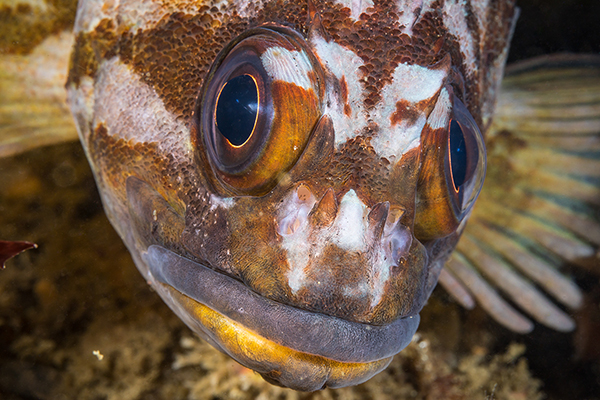
90mm, F/16, 1/200th sec., ISO 200
Click image to view larger
This is a copper rockfish. I like shooting the face on this particular type of fish because they're generally much more tolerant of divers holding a camera right in front of them. A lot of larger fish out there won't allow you to get this close. I think their faces offer the viewer a sense of their personality, so I always try to take a nice portrait when I get the chance.
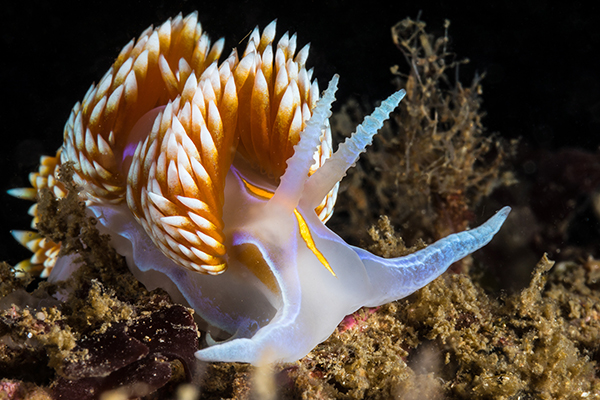
90mm, F/29, 1/200th sec., ISO 200
Click image to view larger
This is the nudibranch (aka sea slug) I talked about earlier. Sea slugs like this are fascinating because they'll eat the stinging cells inside their food source, then transfer them to those spikey things on top of their bodies called cerata. Then, when another fish tries to eat them, those fish will get stung by the stinging cells that the nudibranch absorbed. Fish generally don't touch nudibranches for this reason, even though they're so vibrantly colored. Plus, they taste really bad.
They're neat to photograph because they come in so many different shapes. This one in particular, which is common on the reefs in Southern California, was about 2 centimeters long. I wasn't using a diopter for this, so I'm guessing I was about 4 or 5 centimeters away.
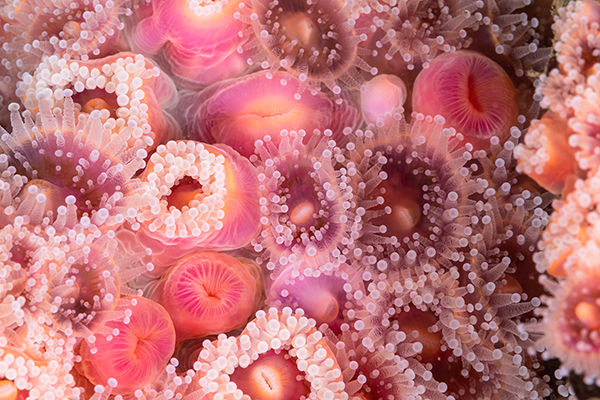
90mm, F/18, 1/200th sec., ISO 200
Click image to view larger
These are called strawberry anemones, often found in the colder areas of water off the coast of California and in the Channel Islands. They grow in colonies that blanket the reef, creating a cover that ranges from purple and pink to white or even orange. I love these creatures because they form amazing abstract patterns that are enjoyable to photograph. I caught this group of anemones filter-feeding and trying to pull in particles from the water. They were on a vertical part of the reef, so I was able to shoot straight on, using my reef stick to help me get close.
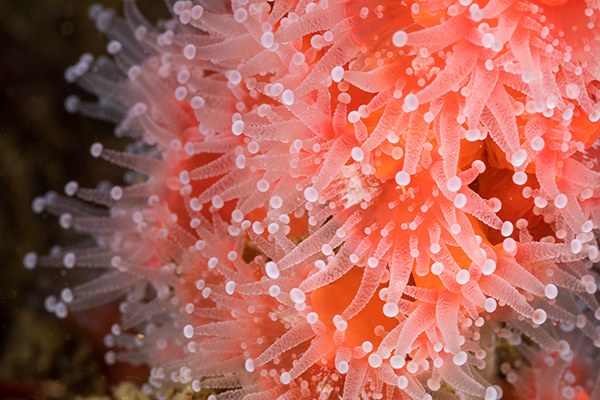
90mm, F/32, 1/200th sec., ISO 200
Click image to view larger
I went after a completely different look for this second photo of a strawberry anemone. There are so many ways, and so many compositions you can use, to photograph very similar subjects underwater. In this case, I also wasn't using my diopter. Instead, I was seeking a bigger subject with more texture so I could show detail even into the corners.
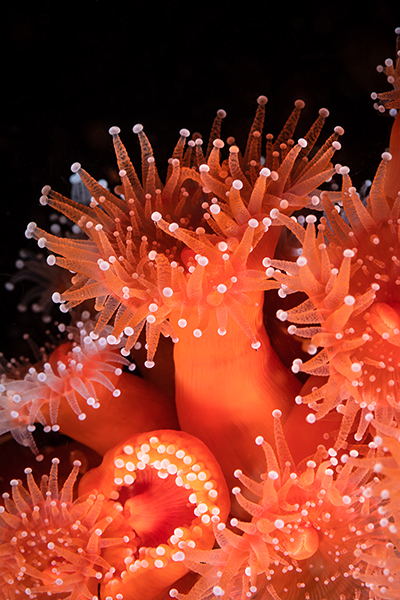
90mm, F/20, 1/200th sec., ISO 320
Click image to view larger
Finally, this third photo of a strawberry anemone kind of resembled a tree, standing up a lot taller than the rest of the anemones around it. I wanted to shoot it from that side angle and focus the light to emphasize the subject, eliminate any clutter in the background, and show more of a color contrast.
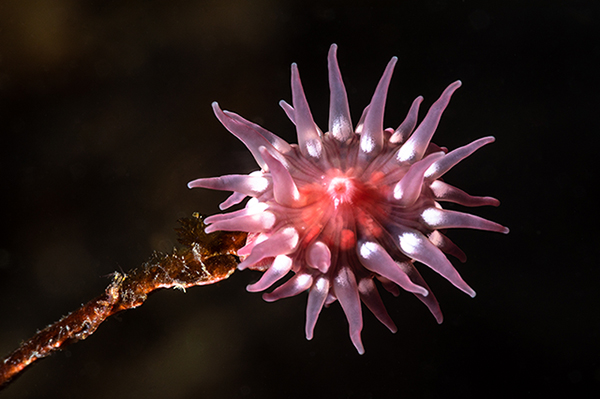
90mm, F/32, 1/200th sec., ISO 320
Click image to view larger
This anemone I found out near the Channel Islands generally attaches itself to the reef or kelp. This particular one was floating on a small piece of kelp, perched right on the very end of it. It reminded me a lot of a flower. Because it was sticking up out of the reef, I knew I could capture a black background behind it and concentrate on some of the color patterning, which is what attracted me to it in the first place. I controlled the lighting by keeping it very tight and not illuminating anything behind the anemone—that's what allowed me to create that dark background and emphasize the flower-type feel.
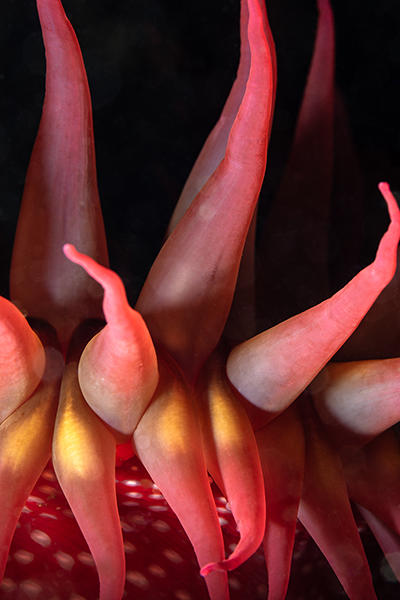
90mm, F/16, 1/200th sec., ISO 320
Click image to view larger
I photographed a cross-section of this white-spotted rose anemone from a 90-degree perspective so I could feature its tentacles. My goal here wasn't to show the whole anemone, but to create a more abstract view and play with the lights and the darks. Once again, I kept tight control over my lighting so I could get that intense light falloff and dark background. This type of shot can be challenging, because the tentacles are always moving, but once you can find just the right angle and the tentacles fall into just the right position, your composition will feel right. It's a cool image because it's so dynamic.
To see more of Brent Durand's work, go to www.brentdurand.com.
More Photo Tips | Watch Videos | Learn More About Tamron Lenses | Photo Gallery
